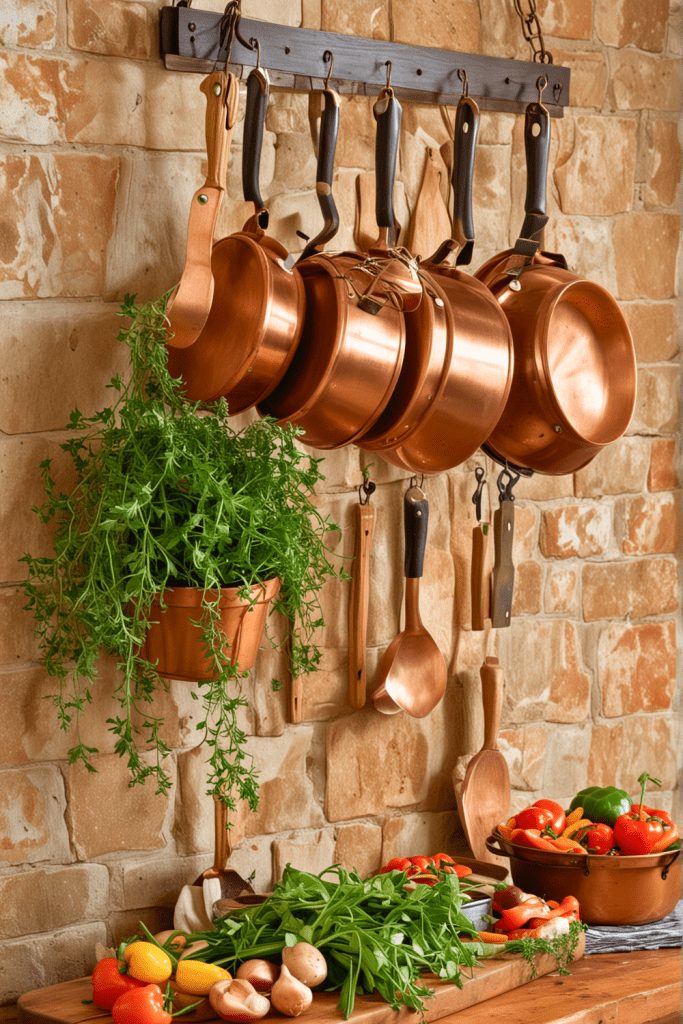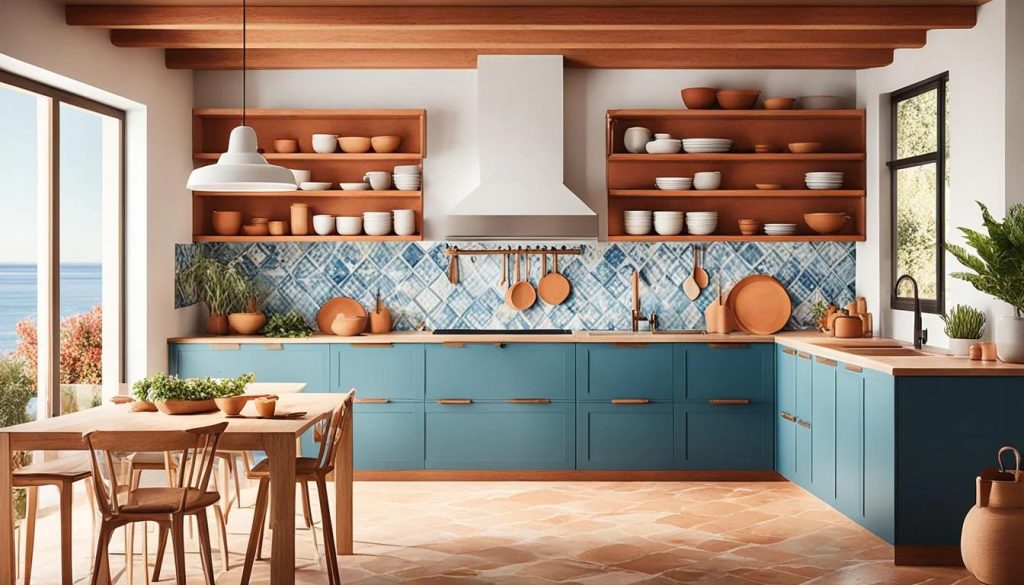The Mediterranean kitchen represents more than just a design aesthetic; it’s a quintessential celebration of warmth, functionality, and timeless elegance.
Rooted in the rich architectural and culinary traditions of countries like Greece, Italy, and Spain, these kitchen designs epitomize a harmonious blend of rustic charm and contemporary sophistication.
Mediterranean Kitchen Ideas
With their evocative color palettes, natural materials, and inviting atmospheres, Mediterranean kitchens transform cooking spaces into vibrant sanctuaries that inspire creativity, connection, and gastronomic passion.
1 Terracotta Tile Flooring

Mediterranean kitchens are intrinsically linked to earthy, natural materials that evoke the sun-drenched landscapes of Southern Europe. Terracotta tile flooring emerges as a quintessential design element that instantly transports you to a quaint coastal village. These handcrafted clay tiles, with their warm, burnt-orange hues and slightly irregular surfaces, bring an authentic, artisanal touch to your kitchen.
The beauty of terracotta lies not just in its aesthetic appeal but also in its remarkable durability. Each tile tells a story of traditional craftsmanship, with subtle variations in color and texture that create a rich, layered visual experience. When installed, these tiles provide a robust, heat-resistant surface that can withstand the rigors of a busy kitchen while maintaining their timeless elegance.
2 Whitewashed Walls and Blue Accents

Drawing inspiration from the iconic Greek islands, particularly the stunning architecture of Santorini, whitewashed walls paired with azure blue accents create a breathtaking Mediterranean narrative. The pristine white walls represent purity, spaciousness, and light, reflecting the brilliant sunshine of coastal regions. They serve as a perfect canvas for introducing vibrant blue elements that evoke the mesmerizing Mediterranean Sea.
Implementing this color scheme goes beyond mere aesthetics. The white walls help create an illusion of expansiveness, making even smaller kitchens feel open and airy. Blue accents, whether through ceramic tiles, kitchen accessories, or painted cabinets, introduce a sense of tranquility and depth. This color combination not only pays homage to Mediterranean design traditions but also creates a serene, uplifting environment for culinary creativity.
Related Guide: 11 Inspiring Spanish Mediterranean Kitchen Ideas
3 Open Shelving with Ceramic Displays

Open shelving is more than a design trend in Mediterranean kitchens; it’s a cultural expression of hospitality and culinary pride. By replacing traditional closed cabinets with open wooden or wrought-iron shelves, you create an opportunity to display beautiful ceramic dishes, colorful pottery, and cherished cooking accessories. These shelves become a visual narrative of your cooking journey and cultural appreciation.
Ceramic pieces in Mediterranean design are not mere decorative elements but functional art. Hand-painted plates from Portugal, intricately designed Turkish bowls, or rustic Italian terracotta cookware can transform your shelves into a stunning display. The key is to curate a collection that tells a story, mixing practical items with decorative pieces that reflect the rich artisanal traditions of Mediterranean cultures.
4 Natural Stone Countertops

Natural stone countertops epitomize the Mediterranean commitment to authenticity and durability. Materials like limestone, marble, and granite not only provide a robust cooking surface but also introduce organic textures and subtle color variations that reflect the region’s geological diversity. These countertops serve as a tactile connection to the natural landscapes of Mediterranean countries.
Limestone, with its soft, neutral tones, offers a particularly Mediterranean aesthetic. Its slightly rough texture and ability to age gracefully make it an ideal choice for kitchens that value character and timelessness. Marble, with its classic veining and luxurious appearance, can introduce an element of sophistication, while granite provides unparalleled durability and resistance to heat and scratches.
5 Herb Garden Window

A dedicated herb garden window is a quintessential Mediterranean kitchen feature that blends functionality with aesthetic charm. By creating a small, sunlit space for growing fresh herbs like basil, rosemary, thyme, and oregano, you not only enhance your culinary capabilities but also introduce a living, fragrant element to your kitchen design.
These herb gardens can be integrated through various methods: a dedicated windowsill, hanging planters, or even a small vertical garden. The key is to ensure adequate sunlight and proper drainage. Beyond their culinary utility, these herb gardens serve as a beautiful design element, bringing vibrant green hues and natural textures into your kitchen space.
6 Wrought Iron Light Fixtures

Lighting plays a crucial role in Mediterranean kitchen design, and wrought iron light fixtures offer the perfect blend of functionality and artistic expression. These hand-crafted fixtures, often featuring intricate scrollwork and traditional designs, serve as stunning focal points that draw inspiration from Spanish and Portuguese architectural traditions.
Pendant lights, chandeliers, and wall sconces in dark, rich iron tones can dramatically transform your kitchen’s ambiance. When strategically placed, they create warm, inviting pools of light that highlight key areas like islands, dining spaces, and cooking zones. The interplay of light and shadow produced by these fixtures adds depth and drama to your Mediterranean-inspired kitchen.
7 Rustic Wooden Elements

Incorporating rustic wooden elements is fundamental to achieving an authentic Mediterranean kitchen aesthetic. Whether through reclaimed wooden beams, wooden island counters, or vintage wooden chairs, these elements introduce warmth, texture, and a sense of history to your cooking space. The wood should ideally feature rich, warm tones that reflect the sun-baked landscapes of Southern Europe.
Olive wood, with its distinctive grain and warm honey-brown hues, is particularly emblematic of Mediterranean design. Salvaged or distressed wood pieces can add character and tell a story of craftsmanship and tradition. The key is to balance these wooden elements with lighter, brighter components to prevent the space from feeling too heavy or dark.
8 Colorful Mosaic Backsplash

A mosaic backsplash represents the artistic soul of Mediterranean design. Drawing inspiration from ancient Roman and Arabic tile work, these intricate designs transform kitchen walls into vibrant canvases. Handcrafted ceramic tiles in a kaleidoscope of colors—blues, greens, yellows, and terracotta—create a dynamic visual landscape that captures the region’s artistic heritage.
The beauty of a mosaic backsplash lies in its ability to be both a functional protective surface and a stunning art piece. Each tile is carefully placed to create complex patterns that tell a story, whether geometric, floral, or abstract. Modern interpretations might use more subdued color palettes while maintaining the intricate craftsmanship that defines Mediterranean design.
Related Guide: 12 Inspiring Greige Kitchen Cabinets Ideas
9 Copper Cookware Display

Copper cookware transcends its practical cooking function in a Mediterranean kitchen, becoming a significant decorative element. These gleaming, hand-hammered pots and pans, when strategically displayed on hanging racks or open shelves, introduce a warm metallic tone that complements the earthier elements of the design.
The rich, luminous quality of copper adds a luxurious touch to the kitchen. Beyond aesthetics, copper is prized in Mediterranean cooking for its superior heat conductivity and timeless appeal. Vintage or artisan-crafted pieces can serve as both functional cooking tools and stunning design elements, reflecting the region’s appreciation for quality craftsmanship.
10 Comfortable Dining Nook

A Mediterranean kitchen is fundamentally about connection—with food, family, and tradition. A comfortable dining nook embodies this philosophy, creating an intimate space that encourages conversation, shared meals, and culinary exploration. Built-in benches with plush cushions, surrounded by rustic wooden tables and adorned with vibrant textiles, capture the essence of Mediterranean hospitality.
The dining nook should feel both casual and inviting. Consider incorporating elements like wrought iron details, ceramic tile accents, or large windows that allow natural light to flood the space. The goal is to create an area that feels like an extension of the cooking space, where meals are not just prepared but celebrated.
Conclusion
Designing a Mediterranean kitchen is an artful journey of blending tradition, functionality, and aesthetic beauty. It’s about creating a space that transcends mere cooking and becomes a vibrant hub of family life, culinary creativity, and cultural expression.
By thoughtfully incorporating elements like natural materials, rich colors, and artisanal touches, you can transform your kitchen into a Mediterranean sanctuary that nourishes both body and soul. Remember, the most important ingredient in any Mediterranean kitchen is the love and passion you bring to the space.

